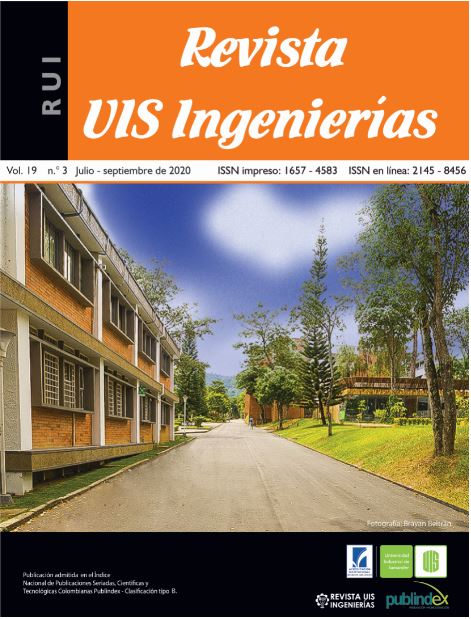Development of an academic software to the calculation of thermal load for the air conditioners course at Pamplona University
Published 2020-05-18
Keywords
- air conditioner,
- thermal load,
- refrigeration,
- heat transfer
How to Cite
Copyright (c) 2020 Revista UIS Ingenierías

This work is licensed under a Creative Commons Attribution-NoDerivatives 4.0 International License.
Abstract
This work presents the development of a Matlab® program to calculate the cooling thermal load in an environment from the use of three methods; Cooling Load Temperature Differential (CLTD) / Cooling Load Factor (CLF) / Solar Cooling Load (SCL) method, approved by the American Society of Heating Engineers, Refrigeration and Air Conditioning (ASHRAE). The program’s goal it´s obtain the thermal load that each of the elements present, be they structural, occupation or equipment, therefore, it is possible to quickly and clearly identify which of them generate the greatest load. thermal to make engineering decisions that favor the reduction of energy consumption.
Downloads
References
[2] K. Morales, C. Hoyos, J. Garcia-Caicedo, “Desarrollo Diseño y optimización de la estructura mecánica de un brazo robótico antropomórfico desarrollado con fines educativos,” Rev. UIS Ing., vol. 18, no. 4, pp. 193–208, 2019, doi: 10.18273/revuin.v18n4-2019017
[3] B. R. Pérez-Gutiérrez, “Comparación de técnicas de mineria de datos para identificar indicios de deserción estudiantil, a partir del desempeño académico,” Rev. UIS Ing., vol. 19, no. 1, pp. 193–204, 2020, doi: 10.18273/revuin.v18n4-2020018
[4] G. M. Contreras, E. Flórez, C. A. P. Cortes, “Aplicación Social De La Asignatura Diseño Mecánico En La Carrera De Ingeniería Mecánica,” Rev. Colomb. Tecnol. Av. (RCTA), vol. 2, no. 20, pp. 65–71, 2013.
[5] A. A. Ávila, E. G. F. Serrano, O. Gualdrón, “Diseño e implementación de un curso interactivo multimedia para el aprendizaje de los procesos CAM en un centro de mecanizado leadwell v30,” Rev. Colomb. Tecnol. Av., vol. 2, no. 20, pp. 50–56, 2013, doi: 10.24054/16927257.v20.n20.2012.188
[6] ASHRAE, Handbook HVAC Systems and Equipment. 2004.
[7] M. Goldsworthy, “Towards a residential air-conditioner usage model for Australia,” Energies, vol. 10, no. 9, 2017, doi: 10.3390/en10091256.
[8] R. Mcdowall, P. Eng, Fundamentals of Air System Design Second Edition (I-P) ASHRAE Learning Institute. 2008.
[9] A. Vedavarz, S. Kumar, M. Hussain, HVAC : Heating, Ventilation and Air Conditioning for Design and Implementation. Industrial Press Inc., 2007.
[10] A. Valverde, M. A. Guerra, “Método de cálculo computarizado para la determinación de las cargas térmicas de refrigeración, aire acondicionado y selección de equipos,” Sci. Tech., vol. 2, no. 31, 2006.
[11] K. M. Murray, Fundamentals of Heating and Cooling Loads. Atlanta: ASHRAE, 2000.
[12] M. Latorre, E. Florez, J. Serrano, “Optimización Del Sistema De Aire Acondicionado De La Universidad De Pamplona A Partir Del Cálculo De La Carga Térmica,” Trabajos fin de grado, Universidad de Pamplona, 2019.
[13] Z. Cataldi, F. Lage, R. Pessacq, R. García Martínez, “Ingeniería de software educativo,” Proc. del V Congr. Int. Ing. Informática, pp. 185–199, 2001.
[14] M. V. Ortega, J. J. Martinez-Lozano, E. Ibargüen-Mondragón, “Modelos estimados de análisis de supervivencia para el tiempo de permanencia de los estudiantes de la Universidad Francisco de Paula Santander,” Respuestas, vol. 21, no. 2, pp. 24–36, 2016, doi: 10.22463/0122820X.775
[15] F. J. García-Peñalvo, “Ingeniería del Software y Gobierno de Tecnologías de la Información,” Universidad de Salamanca, España, 2018.
[16] A. Godoy Muñoz, “El Confort térmico adaptativo. Aplicación en la edificación en España,” proyecto final de maestria, Universitat Politècnica de Cataluña, 2012.
[17] M. D. Suziyana, S. N. Nina, T. M. Yusof, A. A. S. Basirul, “Analysis of heat gain in computer laboratory and excellent centre by using CLTD/CLF/SCL method,” Procedia Eng., vol. 53, pp. 655–664, 2013, doi: 10.1016/j.proeng.2013.02.085
[18] A. K. Singh, M. A. Mishra, M. K. K. Dubey, “Cooling Load Estimation for Library,” Int. J. Emerg. Technol. Eng. Res. Vol., vol. 4, 2016.

